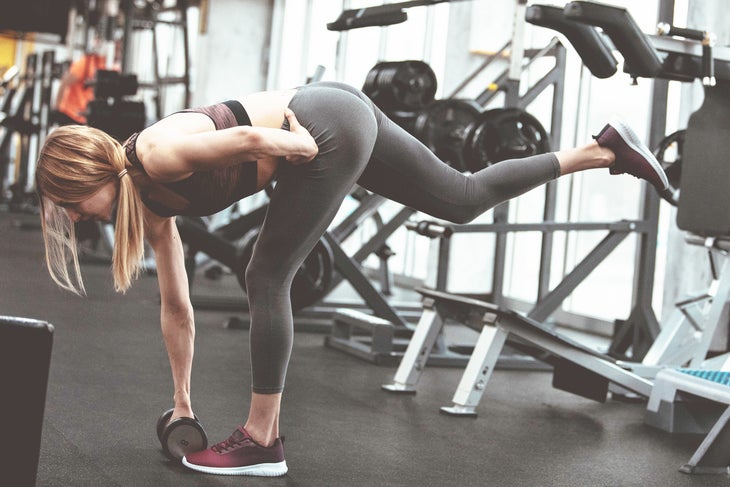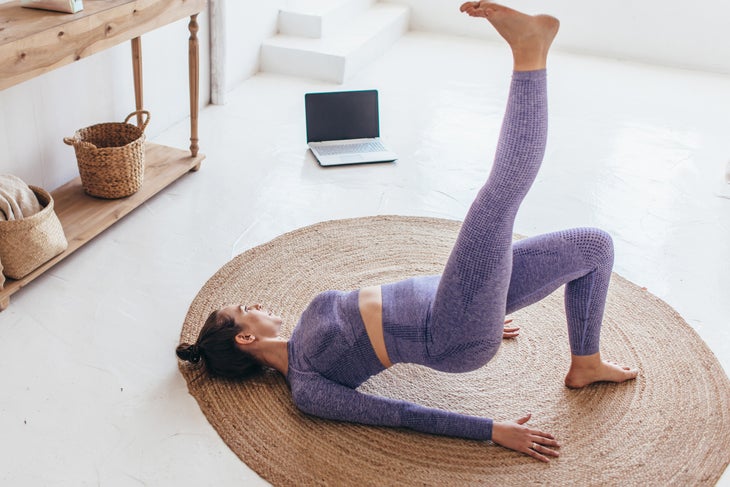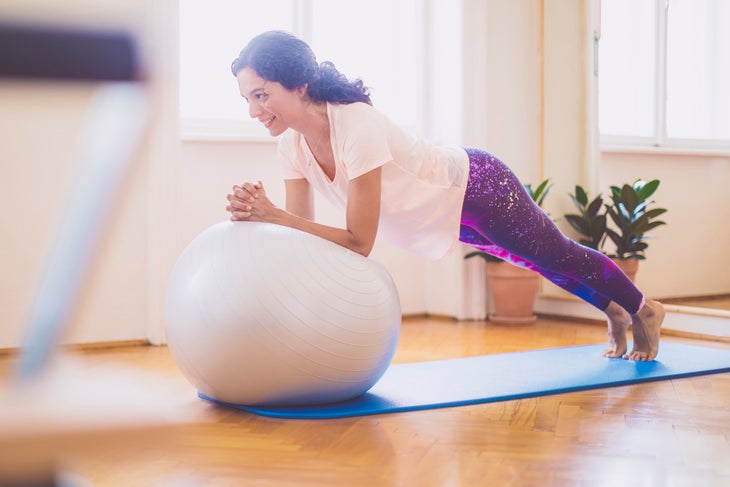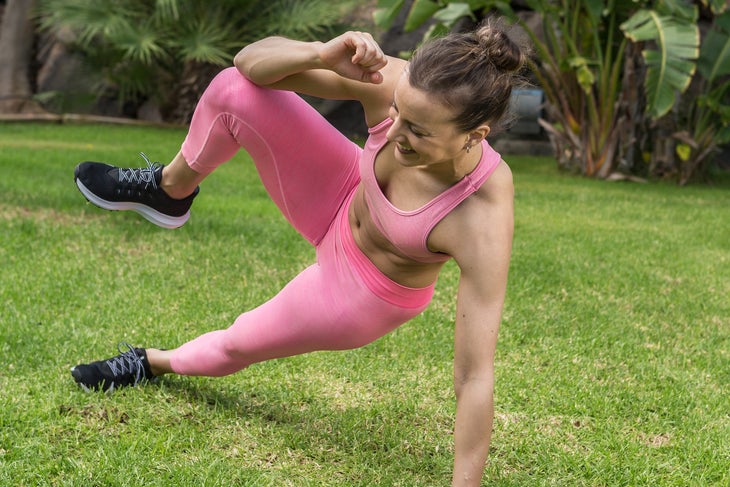Get access to everything we publish when you
sign up for Outside+.
When most runners think about the essential strength training exercises to prevent running injuries and make you a stronger runner, the first thing that comes to mind is squats, lunges, or other leg-oriented exercises. After all, our legs are responsible for the bulk of support and propulsive power in running, and muscle imbalances between groups of leg muscles can increase the risk of common running injuries like shin splints, iliotibial band syndrome, and piriformis syndrome.
That said, while it’s important not to skip “leg day” in the gym, we need to focus on other regions of the body, such as the back. Back pain after running is quite common, but much of the lower back pain caused by running can be prevented by consistently performing a handful of back exercises that also support your running. The best exercises for back pain in runners develop the neuromuscular control, muscular strength, and muscular endurance necessary to maintain proper running form for the duration of your longest runs and races to prevent excessive strain on your back. Not sure where to start? Keep reading for a helpful how-to guide on the best back exercises for runners.
What Causes Low Back Pain in Runners?
There are a variety of root causes and risk factors for low back pain in runners. A 2020 review found that the most common risk factors include physical characteristics, such as height and weight, as well as training errors, like progressing too quickly. New runners are also at a higher risk for experiencing low back pain. The following are some of the most-commonly cited causes and risk factors for lower back pain in runners:
Physical Characteristics
- Being taller
- Leg length discrepancies
- Having a high BMI
Training Errors and Biomechanics
- Overstriding
- Increasing mileage or intensity too quickly
- Wearing worn out shoes
- Excessive downhill running
Musculoskeletal Issues
- Weakness in the core, especially the deep core muscles like the transverse abdominis
- Poor core activation
- Weak gluteal muscles
- Tight hamstrings
- Restricted hip flexion
RELATED: Sitting All Day? This Mobility Plan for Runners Can Be Done Anywhere
The Best Exercises for Lower Back Pain From Running
Most physical therapists agree that aside from fixing training issues (replacing old shoes, warming up properly before running, optimizing stride length, varying running terrain, and progressing volume and intensity of workouts gradually), the three primary treatment and prevention options for low back pain in runners are strengthening the core, increasing flexibility in the hamstrings and hip flexors, and strengthening the back muscles and glutes.
The most effective exercises for preventing low back pain in runners develop the strength and stability the back needs to handle the forces and impacts of running, while controlling trunk rotation. Activating the glutes helps reduce the strain on the hamstrings, further minimizing the pull or strain on back muscles and connective tissues. Having adequate strength in the core and glutes also reduces the workload on the back muscles. Finally, an emphasis on increasing flexibility in the hamstrings and hip flexors and the mobility in the hips prevents strain and tension on back extensors and connective tissues.
The following seven exercises can help get you started on developing the flexibility, mobility, and strength needed to prevent back pain.
1. Forward lunges with rotation.

This total-body exercise is perfect for runners as it strengthens your quads, hips, glutes, hamstrings, and core. In doing so, it is one of the best back exercises to prevent low back pain. Be sure to bend fully into each lunge, flexing your knees to 90 degrees.
- Stand upright with your feet shoulder-width apart, holding a medicine ball parallel to the floor with your arms fully extended straight in front of your body.
- While stepping your right foot forward and dropping down into a lunge, simultaneously rotate your trunk and arms to the right by engaging your obliques. Be sure to keep your arms straight. Your front knee should hover just above the ground without touching it.
- Step back into the upright starting position while rotating the medicine ball back to neutral.
- Alternate legs, completing 15 reps per side.
2. Single-leg Romanian deadlifts.

If you only have the time or attention span for one strengthening exercise in your back pain prehab or rehab program, the single-leg Romanian deadlifts should be your go-to move. This exercise strengthens the entire posterior chain, improves balance and coordination, and helps activate your glutes, hamstrings, deep core muscles, and back extensors—all of which are often the culprits behind low back pain in runners. Although it can be difficult for those with poor balance to master single-leg Romanian deadlifts, if you focus on engaging your glutes, you’ll gain more stability and control.
- Stand with your feet shoulder-width apart, knees slightly bent, chest up, and arms at your sides holding a 5-15 pound dumbbell or kettlebell in your right hand.
- Engage your core and glutes, and then bend your left knee (the one on your standing/support leg) about 20 degrees to activate your hamstrings and glutes while you lift your right leg off the ground.
- Hinge from your hips to bring your torso towards the floor, keeping your gaze on the ground to prevent hyperextending your neck. Simultaneously, reach your right hand with the weight down towards your left foot until you feel enough of a stretch in the hamstrings of your supporting leg. Your right leg should extend behind you as a counterbalance and your torso should be relatively parallel to the floor.
- Squeeze your glutes to stand back up, extending your hips until they are fully locked out.
- Complete 12 reps per side.
RELATED: 6 Functional Fitness Exercises That Will Improve Your Everyday Life
3. Weighted superman.

Most core workouts for runners focus on the abs and obliques, with less attention paid to the erector spinae and spinal stabilizers. This is a great move to prevent low back pain because it works your back extensors, hamstrings, glutes, and shoulders. Adding the dumbbell increases the activation of your rhomboids, shoulders, and traps.
- Lie on your stomach with your arms extended straight overhead on the floor, each hand holding on to either end of a single dumbbell (start with 3-5 pounds).
- Engage your glutes and back muscles to simultaneously lift your upper body, head, and chest along with your lower body. Keep your arms straight as you raise the dumbbell off the floor.
- Hold this position, hovering above the floor for one breath and then return to the starting position.
- Complete 15 reps.
4. Single-leg bridges.

Bridges are one of the more effective strengthening exercises for the gluteal muscle. Another benefit of them is that they can often be performed as part of a rehab program if you are already experiencing pain (but be sure to stop any exercise that elicits pain). This single-leg version better replicates the unilateral nature of running and isolates the glutes on each side for more effective strengthening.
- Lie on your back with your arms at your side, your knees bent, and your feet flat on the floor.
- Extend one leg so that it is pointing up towards the ceiling or simply remove it from the floor and hook it around your other leg.
- Engage your butt muscles and press through your heel to lift your hips off the ground.
- Press your hips up until they form a straight line from your knees to your shoulders.
- Squeeze and hold, and then return to the starting position.
- Complete 15 reps per side.
5. Stirring-the-pot plank.

Standard forearm planks are one of the most frequently prescribed core exercises for runners. Planks strengthen the deep core muscles along with the glutes and low back extensors. This difficult plank variation requires your core muscles to work that much harder, as they have to stabilize your body while you move your arms.
- Get into a forearm plank position with your feet on the ground and your elbows and forearms on a stability ball.
- Engage your core and gluteal muscles, ensuring your body is in a straight line from your head to your feet.
- Slowly make small circles with the stability ball by digging your elbows in and dragging the ball in a circular fashion.
- Complete 15 slow circles, and then switch directions.
6. Side plank with knee drive.

Side planks target your obliques, erector spinae, and deep core muscles such as the transverse abdominis, making them one of the best exercises for preventing lower back pain. This modification further challenges your core by requiring stability while you move your legs. If you are not ready to progress the exercise to this level, just complete a standard side plank for 30 seconds.
- Lie on one side with your elbow stacked directly under your shoulder and your feet stacked on top of one another.
- Lift your hips off the ground and place your top hand on your hip with your elbow bent.
- Slowly bend the knee on your top leg and bring it up towards your chest.
- Hold for one breath and then slowly extend it back to the starting position.
- Complete 12 slow reps and then switch sides.
7. Dead bugs.

This core exercise will strengthen your lower abs and deep core, such as the multifidus along your spine. You can increase the difficulty by adding ankle weights and holding light dumbbells. (For a video of this exercise, check it out in Oxygen’s exercise library, available to Outside+ members.)
- Lie on your back with your knees bent to 90 degrees, shins parallel to the floor, and arms pointing straight up towards the ceiling.
- Inhale, engage your abs, and simultaneously lower one foot towards the floor until your toe nearly taps down and the opposite arm straight back behind you towards the floor without touching it.
- Keep the other leg and arm steady at the starting position.
- Return the leg and arm back to the starting position and repeat with the opposite leg and arm.
- Alternate sides with each rep, moving slowly and with control.
- Complete 15 reps per side.
RELATED: The Painful Truth About Why Your Boobs Hurt When You Run
